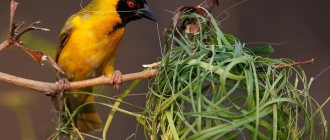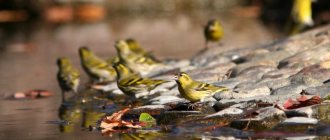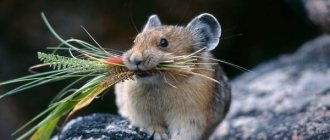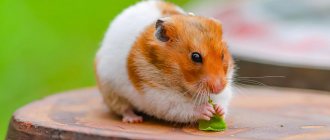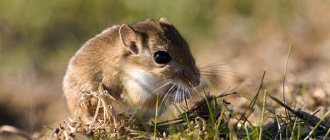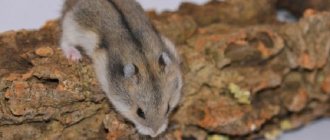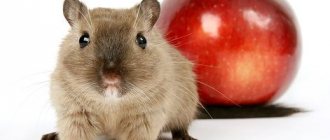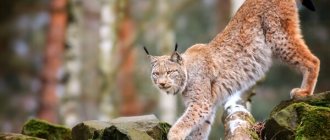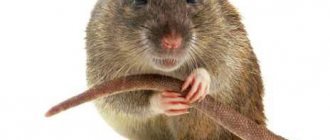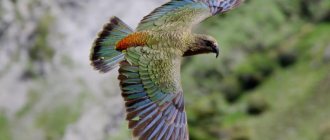In the forests of the wonderful island of Madagascar lives one of the most amazing animals in the world - the little arm, or, as it is also called, the aye-aye. This animal has such an unusual appearance that the natives of Madagascar saw in it a ghost, a fiend of hell, and in general, the source of all their troubles. Having encountered this “terrible” creature, the local population always tried to kill it. As a result of superstitions, and most importantly, due to the destruction of the animal’s habitats, the little arm was on the verge of extinction.
The Madagascar bat (Daubentonia madagascarinensis) is a mammal from the order of primates, a suborder of lemurs, the only representative of the family of bats. This animal was discovered in 1780 by Pierre Sonner, who was engaged in research in the west of Madagascar. He described this creature as a tropical rodent, but later, after long discussions, scientists nevertheless came to the consensus that the aye-aye was not a rodent at all, but a lemur, which, in the course of evolution, deviated somewhat from the general trunk of the group.
Description and features
In 1780, thanks to the research of the scientist Pierre Sonner, an amazing little animal . The beast was rare and even the local residents, according to their assurances, had never seen it.
They were wary of this unusual animal and kept exclaiming “ah-ah” in surprise. Sonner chose these exclamations as the name for an unusual animal, which today is called the Madagascar aye-aye.
From the very beginning, scientists could not attribute it to a specific species of animal and only according to the descriptions of Pierre Sonner they classified it as a rodent. However, after some discussion, it was decided to classify the animal as a lemur, despite the fact that it differs slightly from the general characteristics of the group.
The Madagascar monkey has a very original appearance. The average size of the animal is small, about 35-45 centimeters, weight reaches about 2.5 kilograms, large individuals can weigh 3 kilograms.
The body is protected by long, dark-colored hair, and the long hairs that serve as indicators are half white. The tail of this unusual animal is much longer than the body, large and fluffy, flat, more like a squirrel's. The total length of the animal reaches a meter, of which the tail takes up half - up to 50 centimeters.
A distinctive feature of the Madagascar monkey is its rather large, oversized head with large ears, shaped like leaves. The eyes deserve special attention - large, round, most often yellow with greenish inclusions, which are outlined in dark circles.
The little aye-aye is a nocturnal creature and has excellent eyesight. The muzzle in its structure resembles the muzzle of rodents. It is pointed, equipped with very sharp teeth that are constantly growing. Despite the strange name, the animal has two front and two hind legs, and has long sharp claws on its fingers.
The front legs are slightly shorter than the hind legs, so the arm moves along the ground very slowly. Although he rarely comes down to earth. But once she climbs a tree, her short front legs turn into a huge advantage and help the animal quickly move through the trees.
The structure of the fingers is quite unusual: the middle finger of the hand has no soft tissue, it is very long and thin. The animal uses this finger with a sharp thin nail to obtain food by tapping the bark, and like a fork, it takes out larvae and worms found in the tree, and helps push food into the throat.
When running or walking, the animal bends its middle finger as far inward as possible, for fear of damaging it. The unusual animal is called the most mysterious known. Local Aboriginal tribes have long considered the hand-footed creature to be an inhabitant of hell. It is not known for certain why this happened.
Early descriptions by researchers suggest that Aboriginal people consider this animal to be cursed due to its bright orange round eyes framed by dark circles. The little hand in the photo and in reality looks terrifying, and this is what scientists believe is what instills superstitious fear in the aborigines.
The superstition of the Madagascar tribes says that a person who kills a little arm will be cursed with a quick death. Until now, scientists have not been able to find out the true name of the arm in the Malagasy dialect. In fact, the island animal is very kind; it will never attack first or injure you. In random encounters, he prefers to hide in the shade of trees.
It is very difficult to buy this animal, since it is on the verge of extinction due to superstitious destruction, as well as due to its rare birth rate. It is known for certain that they do not reproduce in captivity.
The female brings only one cub at a time. There are no known cases of two or more babies being born at one time. It is impossible to purchase the pendant for a private collection. The animal is listed in the Red Book.
Interesting facts about the animal
- The little hand knocks on the trees about eight times per second. She spends about 40% of her time searching for food.
- The animals begin looking for food three hours after sunset and spend about 80% of the night time searching for larvae in tree trunks.
- Ai-Ai are having an interesting holiday. Climb a tree using vertical jumps. They go down to the ground if necessary. They mostly jump from tree to tree. At night, they jump over distances of up to 4 km.
- Females are dominant over males. They are not monogamous. In addition to mating, they can interact when feeding the cub.
Kinds
After discovering this unusual animal, scientists classified it as a rodent. After a detailed study, the animal was classified as a semi-order of monkeys. The animal belongs to the group of lemurs, but it is believed that this species took a different path of evolution and turned into a separate branch. At the moment, no species other than the Madagascar aye-aye have been discovered.
An interesting fact is the finds of archaeologists. The remains of an ancient bat after careful reconstruction using computer technology indicate that the ancient beast was much larger than its modern descendants.
Continuation of the family line
The breeding season of nocturnal creatures is not determined, but for primates this is an uncharacteristic feature. Females develop over 2-3 years, calling partners with cries. They choose a mate on the condition that the male has responded to the call, and mate with everyone who came to him.
Females do not give birth to more than one baby at a time, however, pregnancy lasts 170-172 days. For two months the baby does not leave the mother. She arranges a separate nest for him, where the child should live during this time.
Mother's milk remains the main nutrition for the little individual for the first 7 months. As it grows, the cub stays next to its mother for another 1.5 months.
Little arms, like other animals, mark territory.
- Use urine for marking.
- The cries of the creature allow you to claim ownership of the land.
- Among other things, the individuals themselves mark the territory with scent marks, and this may not always be urine.
Lifestyle and habitat
The animal really does not like sunlight and therefore practically does not move during the day. Can't see anything in sunlight. But with the onset of dusk, his vision returns, and he is able to see larvae in the bark of trees at a distance of ten meters.
During the day, the animal is dormant, climbing into a hollow or sitting on a dense plexus of branches. It can be motionless all day. The little arm covers itself with its lush big tail and sleeps. In this state it is very difficult to see. When night comes, the animal comes to life and begins hunting for larvae, worms and small insects, which also lead an active night life.
The little monkey lives exclusively in the forests of Madagascar. All attempts to find the off-island population were unsuccessful. Previously it was believed that the animal lives exclusively in the northern part of the island of Madagascar.
Research has shown that rare specimens are also found in the western part of the island. They love warmth very much and when it rains they can gather in small groups and fall asleep, huddled closely together.
The animal prefers to live in tropical bamboo and mango forests, in a small area. It comes down from trees extremely rarely. He is very reluctant to change his place of residence. This can happen if the offspring are in danger or food runs out in these areas.
The Madagascar bat has very few natural enemies. They are not afraid of snakes and birds of prey, and larger predators do not hunt them. The greatest danger to these unusual animals is humans. In addition to superstitious hatred, there is a gradual deforestation, which is the natural habitat for the little arms.
Threats
One of the main reasons for the extinction of the species is deforestation. Among other things, humans cause considerable harm to representatives.
Photo: Duke Lemur Center/SWNS.com
Many people believe that if they encounter a Madagascar monkey, death awaits the traveler. That is why superstitious people try to kill the animal quickly in order to avoid the curse. However, even the one who dares to kill the creature will pass away within a year.
Farmers pose a significant threat to animals. Since they feed on plantations, many people mistake them for rodents and also try to exterminate them.
Nutrition
The little hand is not a predator. It feeds exclusively on insects and their larvae. Living in trees, the animal listens very sensitively to buzzing insects flying past, crickets, caterpillars or worms swarming in the dry bark. Sometimes they can catch butterflies or dragonflies. Larger animals are not attacked and prefer to stay away.
Thanks to the special structure of its front paws, the little arm very carefully taps the bark of trees for the presence of larvae, and carefully examines the branches of the trees on which it lives. The sinewy middle finger is used by the animal as a drumstick, indicating the presence of food.
Then the hunter chews the bark with sharp teeth, takes out the larvae and, using the same thin finger, pushes the food into the throat. It has been officially established that the animal is capable of detecting the movement of insects at a depth of up to four meters.
Loves little arms and fruits. Having found the fruit, she gnaws the pulp. Loves coconuts. She taps them, just like the bark, to determine the amount of coconut milk inside, and then simply chews the nut she likes. The diet includes bamboo and reed. Just like hard fruits, the animal gnaws the hard part and selects the pulp with its finger.
Aye-aye hands have a range of sound signals. With the onset of dusk, animals very actively begin to move through the trees in search of food. At the same time, they make a loud sound, similar to the grunting of a wild boar.
To drive other individuals away from their territories, the little arm can emit a loud cry. He speaks of an aggressive attitude; it is better not to approach such an animal. Sometimes you can hear some sobbing. The animal makes all these sounds in the fight for territories rich in food.
The animal does not play a special role in the food chain of Madagascar. She is not hunted. However, it is an integral part of the island's ecosystem. Interestingly, there are no woodpeckers or birds similar to them on the island. Thanks to the feeding system, the little hand does the “work” of woodpeckers - it cleans the trees of pests, insects and their larvae.
Aye-aye lifestyle
The little hand leads an exclusively nocturnal lifestyle. She spends the day in a nest, which she builds herself from branches and leaves at a height of 10–15 m above the ground. It takes about a day to build a nest. Each animal uses several nests in a certain order, and different individuals rest in one nest every day. The aye-aye prefers to move along tree branches, but can descend to the ground to cross a forest clearing.
Little hands lead a predominantly solitary lifestyle. In places where food is abundant, several individuals can gather at once, but females are usually intolerant of each other's presence.
Each individual has an individual plot, the area of which is often more than 30 hectares. With the help of scent marks, urine and screams, little arms claim rights to their territory. The feeding areas of males overlap with those of females.
The main diet of the hand-footed insect is insect larvae and the soft contents of fruits. Aye-aye is a frequent visitor to coconut palm plantations. Before gnawing through a coconut shell, the animal taps the fruit to assess whether it contains a lot of milk.
It is not known exactly how long bats live in nature, but in zoos their lifespan is quite long - up to 26 years.
Baby monkey born at San Diego Zoo
Diet
The crayfish diet includes:
- insect larvae;
- soft fruit contents;
- coconuts;
- mushrooms;
- growths on tree bark;
- fruits.
Coconut plantations are the most favorite place for animals. It is here that there is an abundance of various kinds of nuts, fruits and vegetables. Before eating a coconut, the animal knocks on it to check the amount of milk inside.
The larvae are caught in a similar way: they tap the birch bark with their middle finger and check for food. After this, the individuals gnaw through the bark, pull out the prey onto the third finger and swallow it.
The creatures also tap fruits, mushrooms and nuts in order to find out the contents, since they consume exclusively the pulp. Such a diet allows representatives of the species to be classified as omnivores.
Can the Madagascar bat be tamed?
It is, of course, possible to keep this creature at home, but it is not recommended. As you already know, these are nocturnal animals, which means that the little arm and its owner will be “out of the way.” When the owner is sleeping, the animal is awake. And vice versa
If we take into account the fact that the diet of little arms must necessarily include not only tropical fruits, but also live insects (and their larvae), then at night it will not be so easy to provide your pet with such a “ration”! Don’t forget that the Madagascar bat is a resident of the southern island of Madagascar, which means it needs a mild and warm climate, which in Russian realities will not be so easy to do. Since these creatures cannot tolerate daylight, they will need to be kept in the dark at all times in case they suddenly wake up during daylight hours. Otherwise you will scare your pet.
In zoos where aye-ayes are kept, all the necessary conditions are available for them. In home realities, this is unlikely to be done, so it is better not to torture either the animal or yourself.
How do vampire bats hunt?
As befits vampires, bats go hunting under the cover of darkness. They find their victims using their sense of smell and hearing. The ability to echolocation in bloodsucking bats is poorly developed.
Females from one group hunt in a certain territory, but each has its own food sources, which they jealously guard from each other.
Even with rich hunting grounds, it is not so easy to profit from blood. The vampire first needs to use thermoreceptors on the nasal process to find a warm area of skin where the blood vessels are close to the surface (the bite is usually applied near the ear or on the neck - these are the places where many capillaries are located). When a suitable place is found, the vampire moistens it with saliva containing an anesthetic substance. Then, using razor-sharp incisors, the desmodes cut off a tiny piece of skin, leaving a small bleeding wound. Anticoagulants (substances that prevent blood from clotting) that enter the frame with saliva ensure bleeding for the entire time until the vampire is satisfied.
Scientists have found that a vampire's meal can last 9-40 minutes, and in a year one individual drinks more than 10 liters of blood! Animals constantly exposed to nightly attacks by vampires lose strength and often die. Diseases spread by vampire bats also kill significant numbers of livestock.
Bloodletting experience comes with age. In one and a half year old bloodsuckers, only one hunt out of three is successful. Adult and experienced animals remain hungry on average only once every 10 days. Failures most often occur due to the fact that the victim tries to scratch the bitten area or shake the bloodsucker. It is not surprising that the young sometimes feed with their mothers from the same wound, either simultaneously or alternately, often attacking the same victim every night.
In the photo, a vampire bat uses razor-sharp incisors to remove a flap of skin and drink the blood oozing from the wound.
Mutual assistance among bats
Sharing blood is a rare example of mutual support among animals. Vampires who are unsuccessful in their hunt, upon returning to their shelter, begin to beg for blood from their relatives. A hungry neighbor can immediately identify a well-fed neighbor - the lucky one returns from hunting with swollen sides. The likelihood of getting what you expected depends on the level of acquaintance or relationship with the person being groomed. If the starving man is lucky, his neighbor will share his food by regurgitating it directly into his mouth.
Studies conducted by zoologists have found that bats remember which particular tribesmen helped them in their time of need, and when a hungry day comes for a conscientious and generous vampire, the debtor returns his debt. If the “beggar” only accepted “donations”, but did not want to share the blood himself, he may not count on an “act of support”.
The thing is that these animals cannot do without food. If a vampire bat does not eat for three days, death is inevitable. Without mutual assistance, the mortality rate of vampires would reach 80% per year. And under the current state of affairs, they live in nature for more than 15 years.
Tarsier
Many have heard that there is a small animal that lives in the Philippines and is famous for its unusually large eyes. In its homeland it was called “tarsier”. Among mammals, it ranks first in terms of the ratio of eye size to body size. Thanks to this, he was included in the Guinness Book of Records. This small animal with large eyes has a body weight of only 134 grams. Females weigh even less - only 117 grams. Accordingly, they have a small body size, which usually ranges from 10 to 15 centimeters. But their eyes are surprisingly large, and each of them weighs more than the animal's brain. If a person had the same height-to-eye ratio, it would look as if we had grapefruits inserted into our eye sockets.
The tarsier is nocturnal. He navigates very well in the dark, and he is also able to see ultraviolet light. But this baby cannot distinguish colors. The animal is not dangerous to society, but on the contrary, eats various insects and worms. If someone manages to tame it, the tarsier will turn out to be a good assistant to its owner in exterminating parasites. But this cute animal with big eyes has great difficulty getting used to a person and may not get along with him. So, the diet of this big-eyed bird includes spiders, small vertebrates, lizards and insects. To feed, the baby grabs the victim with both paws and does not let go. Interestingly, tarsiers can turn their necks 360°, and this fact used to frighten local residents very much, who thought that the head of these animals was separated from the body.
Breeding in captivity
Most aye-ayes live up to 26 years. However, there are several nature reserves where people are strictly prohibited from entering, much less feeding the animals themselves. Thanks to the proper arrangement of zoos and breeding sites, the population began to grow as natural mating occurs.
Most forest inhabitants reproduce quite rarely in captivity, although there have already been several such cases.
The animal looks quite interesting, since large eyes, a fluffy and elongated tail, as well as paws similar to human fingers, significantly distinguish them from other species.
Great article 3
Notes
- ↑ Gladkova T. D. Primates squad // Animal life. Volume 7. Mammals / ed. V. E. Sokolova. — 2nd ed. - M.: Education, 1989. - P. 129-130. — 558 p. — ISBN 5-09-001434-5
- ↑ Jolly E., Albignac R., Petter J.-J. Lemurs // Madagascar (Series: Golden Fund of the Biosphere) / trans. from English, scientific ed. B. D. Vasiliev, resp. ed. series by V. E. Sokolov. - M.: Progress, 1990. - P. 242-243. — 296 p. — ISBN 5-01-002049-1
- ↑ Biological encyclopedic dictionary / Ch. ed. M. S. Gilyarov; Editorial team: A. A. Baev, G. G. Vinberg, G. A. Zavarzin, etc. - M.: Sov. encyclopedia, 1986. - P. 549. - 831 p. — 100,000 copies.
- ↑ Sokolov V. E.
Five-language dictionary of animal names. Mammals. Latin, Russian, English, German, French. / under the general editorship of academician. V. E. Sokolova. - M.: Rus. lang., 1984. - P. 84. - 10,000 copies. - ↑ Fisher D., Simon N., Vincent D. The Red Book. Wildlife in danger / trans. from English, ed. A. G. Bannikova. - M.: Progress, 1976. - P. 50-54. — 478 p.
- "Big Encyclopedia" ed. Yuzhakova, 1901-1909.
- ↑ “Dictionary of modern Russian literary language” in 20 volumes, vol. 1, 1991.
- Bo Beolens, Michael Watkins, and Mike Grayson.
The eponym dictionary of mammals. - Baltimore: The Johns Hopkins University Press, 2009. - P. 101. - 574 p. — ISBN 978-0-8018-9304-9. - Vasiliev D. B.
Afterword // Madagascar / Rep. ed. series by V. E. Sokolov. - M.: Progress, 1990. - (Golden Fund of the Biosphere). — ISBN 5-01-002049-1.. — P. 276.
Chinchilla
The animal is a native American inhabitant of the order of rodents. It is difficult to spot the animal in the wild; their population is small and lives in the mountains. Because of their incredibly soft and beautiful skin, chinchillas were practically exterminated back in the 19th century.
The animal has a round head on a short neck, long whiskers (up to 10 cm) and round, large ears (up to 5 cm). There is a membrane in the concha of the ear that covers the ear canal when the chinchilla bathes in the sand. It grows in length up to 25-35 cm with a tail up to 15-20 cm, weighs slightly less than a kilogram. The animal is very flexible and can crawl into the smallest gap. The presence of long, strong hind legs (2 times larger than the front ones) allows him to make high, two-meter jumps.
Nowadays, the rodent has gained popularity as a pet. It is recommended to keep him in a spacious cage or enclosure and, after getting used to it, let him out for indoor walks.
What kind of animal is this?
Aye-aye, or simply aye-aye, is a mammal classified as a special species of lemur. The little hand represents the only species from the family of the same name. Nevertheless, in appearance it is completely different from either its fellow lemurs or monkeys in general. Scientists note that the Madagascan monkey (a photo of this unusual prosimian is presented in the article) is closer in its kinship to squirrels or cats. Even in its size, the animal resembles a domestic cat.
They actually exist
Meanwhile, zebroids actually exist. This is a hybrid of a horse and a zebra. As a rule, a horse is the mother of such a foal, and a zebra acts as its father.
The zebroid or zorses, as they are called in the English-speaking world, is an unusually beautiful and interesting animal.
From zebras, such hybrids inherit a wild, freedom-loving disposition and a proud, independent character. However, hybrids also get the curiosity and wariness inherent in zebras.
Zebroids take all the best from horses, from color to qualities such as loyalty, friendliness, intelligence, and endurance.
Millions of people find peace of mind in parked cars during quarantine
Richard Gere and his wife celebrated their wedding anniversary and showed archival photos
Adele returns: the singer is back on social networks and thanks health workers
Zebroids are not rare animals at all, but practically nothing is known about them in Europe. But in Africa they are specially bred, just like ordinary horses.
Hybrids have been used since ancient times as “trekking animals”, that is, they transport people and various not particularly heavy or bulky cargo through “hard”, complex landscapes.
Zebroids are much hardier than ordinary horses, they require much less water, and they can feed on almost anything they can find under their feet. In addition, hybrids have better health, they practically do not get sick.
Apocalypse in reality. A powerful sandstorm covered the capital of Niger: video
50 Shades of Dakota Johnson: the actress presents the new film “Assistant to the Star”
Talk about him with friends: how a girl can develop a sense of masculinity in a guy
